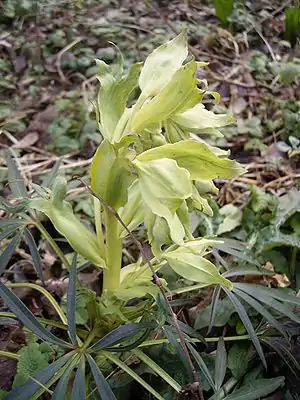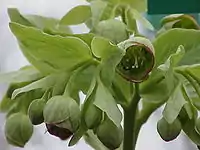| Stinking Hellebore | |
|---|---|
 | |
| Binomial: | Helleborus foetidus |
| Type: | Herbaceous perennial |
| Light requirements: | Sun to shade |
| Water requirements: | Drought tolerant |
| Soil requirements: | Rich, well-drained |
| Pruning season: | After flowering |
| Transplant: | Transplants easily |
| Disease issues: | Some serious |
| Bloom season: | Mid-winter to early spring |
| Weediness: | Self-seeds freely |
| Pollination: | Insects |
| Height and spread: | About 1 ft. high, to 2 ft. spread |
| Root: | fibrous |
| Toxicity and edibility: | Toxic if eaten, can cause rashes on exposed skin |
Helleborus foetidus, known variously as Stinking hellebore, Dungwort, or Bear's foot, is a member of the buttercup family Ranunculaceae, native to western Europe, from England south to Portugal, and east to Germany and Italy.
Description
It is a herbaceous perennial plant growing to 80 cm tall and 100 cm across, with evergreen leaves. The flowers are yellowish-green, often with a purple edge to the five petal-like sepals on strongly upright stems. Foliage is pungent when crushed.
Growing Conditions
Helleborus foetidus prefers woodland conditions with deep, fertile, moist, humus rich, well drained soil, and dappled shade. The species is, however, drought tolerant.
Varieties
The cultivar Green Giant has very bright green flowers and finley divided foliage; Miss Jekyll has fragrant flowers, intensity varying with the time of day; Wester Flisk Group has red tinted leaves and stems and gray-green flowers; the Sierra Nevada Group is dwarf reaching 30 cm.
Uses
It is grown in gardens for its handsome evergreen foliage and large numbers green, bell shaped flowers borne in late winter. Because of its toxicity, it is often grown where Deer are a problem.
Maintenance
This plant tends to be somewhat short-lived in the garden, but replaces itself well with copious seedlings. Deadhead to prevent reseeding, and remove the plant if it has blackened leaves or stems.
Propagation
Propagations is via division or from seed, which can be prolific, naturalising well in ideal conditions.
Pests and Diseases
(see Helleborus for a discussion of pests and diseases).
References

- FAMILY_XREF=&GENUS_XREF=Helleborus&SPECIES_XREF=foetidus&TAXON_NAME_XREF=&RANK= Flora Europaea: Helleborus foetidus
- Flora, The Gardener's Bible, ABC books, Ultimo, NSW, Australia, 2006
- Th Ultimate Plant Book, Bryant & Rodd et al, CSIRO Publishing, Collingwood, Vic, Australia, 2005